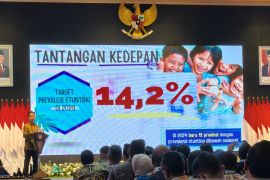To improve the quality of human resources, the intergenerational malnutrition cycle must be broken within the two generationsJakarta (ANTARA) - Two generations in a family could determine the likelihood of a child being born stunted, according to the National Population and Family Planning Agency (BKKBN).
“(The issue of) stunted babies are one of the focus areas of this state. To improve the quality of human resources, the intergenerational malnutrition cycle must be broken within the two generations," Deputy for Family Planning and Reproductive Health at the National Population and Family Planning Agency Eni Gustina stated here on Thursday.
Gustina noted that a girl has ovaries that produce eggs at a young age. The ovaries produce, store, and release eggs during ovulation, and in the event of fertilization, the egg embeds itself in the endometrium and begins its growth when women get pregnant.
If since childhood, the mother-to-be has been malnourished or has anemia, then the risk of having a baby with stunted condition would be high. This cycle would repeat itself, thereby necessitating more treatment to stop the condition from being passed to the next generation or from getting worse.
In order to address the issue, teenagers must maintain good reproductive health by ensuring that young men stop smoking in order to maintain good quality of sperms and maintaining a balanced nutritional intake among young women.
It is also important for teenagers to plan on starting a family in future by getting married at the right age, such as 21 years for girls and 25 years for boys. They must also check their health at a health facility three months prior to marriage.
"Stunting obviously (results in) shortness, but being short is not necessarily being stunted (in growth). Children could be considered to be stunted if there was an impact on cognitive ability, such as a lack of thinking (capacity). We also have to be careful when their height does not match the normal size," she cautioned.
Chairperson of the Indonesian Pediatrician Association, Piprim Basarah Yanuarso, emphasized that the stunting syndrome can occur repeatedly in children.
“This syndrome can be repeated, starting from neonates, two years old, school age, and puberty, to adulthood, (ad infinitum). When we do not have a strategy to break this cycle, a stunted mother (would) give birth to another stunted child and so on," he remarked.
In order to ensure good quality of a generation, it is necessary to pay attention right from childhood to adolescence and to the young adulthood phase.
The likelihood for stunting syndrome occurring repeatedly has necessitated mothers to give special attention during each cycle she goes through, he noted.
During early pregnancy, women should consume more healthy foods, such as eggs and fish, in order to prevent malnourishment. It is also necessary to increase the nutritional value of the food consumed by mothers, including iodized salt.
Moreover, exclusive breastfeeding is important to ensure that the nutritional needs of the baby, during the first six months of its life, are fulfilled, so as to avoid stunting issues.
"I often say that if a mother wants her breast milk to be of good quality, then she has to drink a lot of water -- at least three litres a day -- and she has to eat a lot of animal protein because the mother will produce breast milk that will (assist in her baby's growth)," he stated.
Related news: North Sumatra's 13 districts, cities have high stunting rate: BKKBN
Related news: BKKBN boosts role of varsities in stunting reduction
Related news: E Java among prioritized provinces for stunting handling: BKKBN
Translator: Hreeloita D S, Mecca Yumna
Editor: Sri Haryati
Copyright © ANTARA 2022












